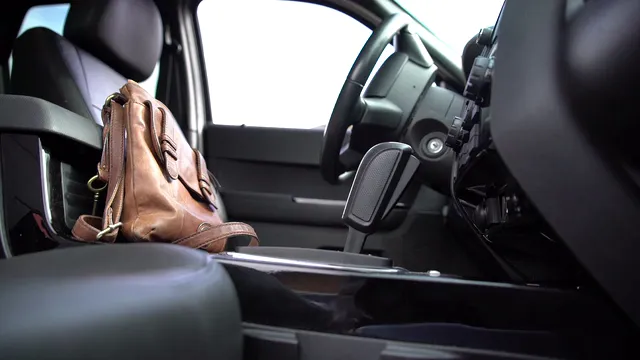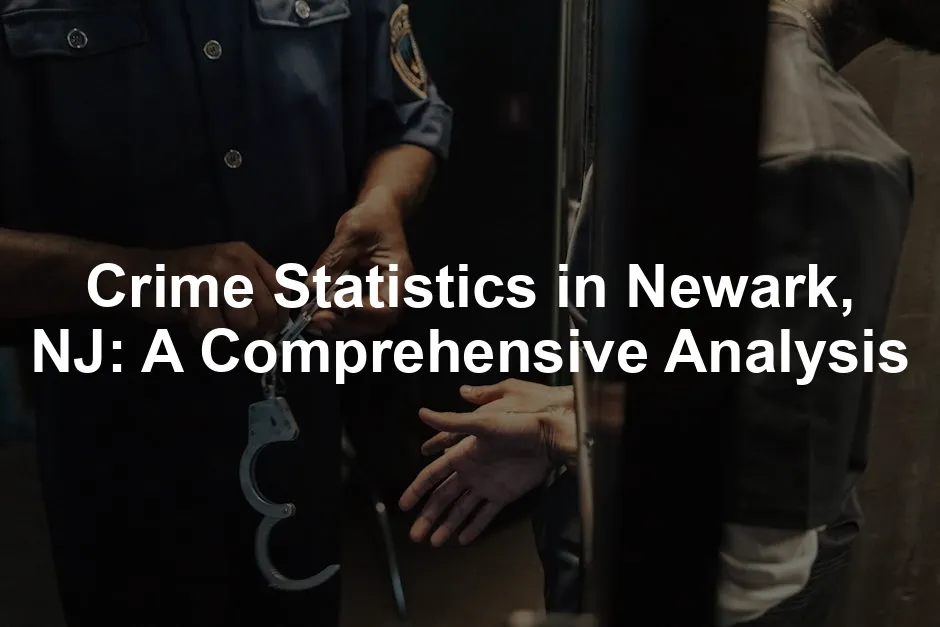Introduction
Crime statistics are essential for anyone living in or considering a move to Newark, NJ. They offer a window into the city’s safety landscape, helping residents and potential movers understand what to expect. For researchers, these statistics provide valuable insights into urban crime trends that can influence public policy and community programs.
Over the years, Newark has grappled with varying perceptions of safety. Once labeled one of America’s most dangerous cities, recent initiatives have aimed to change that narrative. Although crime rates have fluctuated, there’s been a noticeable focus on community policing strategies and innovative crime prevention methods, which have contributed to a more positive outlook.
Understanding Newark’s crime statistics is critical for community safety and awareness. It empowers citizens to make informed decisions and fosters a proactive approach to crime prevention. This article aims to equip readers with knowledge about crime types, current statistics, and trends, ultimately shedding light on Newark’s evolving safety climate.
Readers can expect to learn about the types of crimes prevalent in Newark, analyze recent statistics, and compare them to national averages. This comprehensive analysis will help paint a clearer picture of Newark’s crime situation, providing the context needed for informed discussions around safety and community engagement.

Before diving deeper into the statistics, let’s make sure you feel safe at home. A Home Security Camera System can be a great first step in ensuring your safety. It provides peace of mind, allowing you to monitor your property even when you’re away. After all, who doesn’t want to keep an eye on their domain? Plus, it’s a great way to catch that pesky raccoon that keeps raiding your trash!
Understanding Newark’s Crime Rate
Overview of Crime Types
In Newark, crime can be categorized into two primary types: violent and property crimes. Violent crimes include serious offenses such as murder, rape, robbery, and aggravated assault. These crimes involve force or the threat of force against individuals. On the other hand, property crimes encompass burglary, theft, and vehicle theft, focusing on the unlawful taking or destruction of someone else’s property.
Understanding these distinctions is vital for Newark residents. Violent crimes often spark immediate fear and concern, while property crimes can lead to longer-term anxiety about safety and security in neighborhoods. Awareness of the types of crimes occurring in the area enables residents to take appropriate precautions and engage in community safety initiatives.

Speaking of precautions, if you’re looking for a personal safety solution, consider a Personal Safety Alarm. It’s like having a mini bodyguard in your pocket—just pull the pin, and it’ll make a noise that could wake the neighbors! Perfect for those late-night walks or even just to keep in your bag for peace of mind.
Current Crime Statistics
Recent statistics reveal a complex picture of crime in Newark. According to the latest data from the Newark Department of Public Safety, the total crime rate stands at approximately 7,121 incidents per 100,000 people. This figure includes both violent and property crimes, which are significant concerns for the community.
- Violent Crime Rate: Newark has a violent crime rate of 1,582 incidents per 100,000 residents. This rate is 41% higher than the national average, indicating a pressing issue for public safety.
- Property Crime Rate: The property crime rate in Newark is recorded at 5,539 incidents per 100,000 residents. While this number is lower than the national average, it still raises alarms, especially considering the increasing rates of auto theft and theft from vehicles.
Comparing these statistics to national figures, Newark’s violent crime rate significantly exceeds the national average of 203 incidents per 100,000 people. Property crime rates also show a discrepancy, with Newark’s numbers being notably higher.
According to the NPSC data dashboard, there has been an 11% increase in violent crimes from January to September 2024 compared to the same period in 2023. This uptick is largely due to increases in aggravated assaults and robberies. However, property crime incidents have seen a 12% decrease citywide, with auto thefts decreasing while theft from autos surged by 55%.
This data underlines the importance of ongoing community efforts and effective law enforcement strategies in Newark. Understanding these crime statistics allows residents to remain vigilant and engage in community safety programs that address the roots of crime in their neighborhoods.
For an in-depth analysis of Newark’s crime statistics, you can refer to this article: Newark crime statistics.

Historical Comparison
Newark’s crime rates have undergone significant changes over the last decade. In the early 2010s, the city faced some of its highest violent crime rates, often ranking among the most dangerous cities in America. However, recent statistics show a positive shift. From 2013 to 2023, Newark has experienced a gradual decline in violent crimes, particularly homicides. For example, the number of homicides dropped from 112 in 2013 to just 47 in 2023, marking the lowest rate since 1960.
However, not all crime categories are on the decline. Reports indicate that property crime rates have fluctuated, with a notable increase in auto thefts. The city recorded a staggering 98% rise in auto thefts from 2022 to 2023. This uptick highlights ongoing challenges Newark faces, even amidst improvements in other areas.
Specific trends are evident when examining categories like robbery and aggravated assault. While overall violent crime saw a 10% decrease in 2023 compared to the previous year, the increase in serious assaults is a concern. The data suggests that although Newark is becoming safer, certain areas still grapple with persistent issues.

Recent Trends in Violent Crimes
Current Violent Crime Statistics
In 2023, Newark reported concerning trends in violent crimes. The overall violent crime rate stood at approximately 1,582 incidents per 100,000 residents. This figure is significantly higher than the national average of 203 incidents per 100,000 people.
Breaking it down, the statistics for specific violent crimes are alarming:
- Murder: 47 cases, a decrease from 53 in 2022.
- Assault: 974 incidents, showing a slight increase from previous years.
- Robbery: 469 incidents, highlighting a pressing issue for law enforcement.
Notably, there was a 1% increase in reported rapes, diverging from the overall trend of decreasing violent crimes. The data indicates that while Newark is on the path to becoming a safer city, challenges remain.

Areas of Concern
Certain neighborhoods in Newark exhibit higher rates of violent crime, raising red flags for residents and law enforcement alike. Areas such as Springfield-Belmont, Dayton-Weequahic Park, and South Broad Street are known for elevated crime rates. For instance, Springfield-Belmont has a total crime rate of 3,057 offenses, with a violent crime rate of 753 offenses.
Several contributing factors exacerbate these issues. Socio-economic conditions play a significant role; neighborhoods with high unemployment and poverty rates often see increased crime. Additionally, proximity to establishments like bodegas and bars contributes to higher incidents of violence. A study highlighted that 53% of shooting incidents in 2023 occurred within two blocks of such locations.
As Newark aims to address these challenges, the city is implementing community-oriented policing strategies. These initiatives focus on engaging residents to foster trust and cooperation between law enforcement and the community. By tackling the root causes of crime, Newark hopes to create a safer environment for all its residents.

On a personal level, staying safe is paramount. Consider investing in a Self-Defense Keychain. It’s a compact tool that can fit right in your pocket, giving you a little extra confidence during those late-night strolls. In a pinch, it can be your best friend!
Community Impact
Violent crime in Newark doesn’t just make headlines; it shapes community sentiment. High crime rates breed anxiety and fear, affecting how residents perceive their neighborhoods. Many families feel apprehensive about their safety, especially during late hours.
Local resident Maria Rodriguez shared her concerns: “Every time I hear a siren, I get nervous. It’s like a constant reminder of the dangers that lurk outside.” Her sentiments echo those of other residents who feel on edge.
John Smith, another Newarkian, noted, “I used to walk my dog at night, but now I avoid it. The crime rate has changed how I live my life.” These testimonials reveal how violent crime impacts quality of life. Residents often change their routines, avoiding certain areas and limiting outdoor activities.
The community is resilient, though. Many residents are involved in grassroots initiatives aimed at improving safety. Neighborhood watch groups have emerged, promoting vigilance and cooperation. Still, the lingering effects of crime on mental well-being can’t be overlooked.

For those looking to enhance their home safety, a Smart Door Lock could be a game-changer. Imagine a lock that you can control from your phone—no more fumbling with keys! Plus, it adds an extra layer of security that might just keep that raccoon from getting too comfortable.
Trends in Property Crimes
Current Property Crime Statistics
Property crime in Newark remains a pressing concern. As of 2024, the property crime rate stands at 5,539 incidents per 100,000 residents. This figure includes various offenses: burglary, larceny, and auto theft.
To put this into perspective, Newark’s property crime rate is slightly lower than the national average, which sits at about 1,417 incidents per 100,000 people. However, this doesn’t diminish the anxiety felt by Newark residents over the rising property crime incidents.
In recent reports, auto thefts have surged alarmingly, with 2,133 incidents recorded in 2023 alone. Comparatively, the national average for vehicle theft is just 159.6 per 100,000. This shows Newark is facing unique challenges, particularly in the realm of auto-related crimes.

Rising Issues
One specific issue is the rise in thefts from vehicles. This crime type has skyrocketed by 55% in the last year. Many residents attribute this spike to social media trends and challenges that encourage car thefts. Police Chief Emanuel Miranda has commented, “We’ve seen a direct correlation between social media challenges and the increase in auto thefts. It’s a concerning trend that we’re actively addressing.”
Economic factors also contribute to the ongoing rise in property crimes. With an unemployment rate hovering around 6.5%, many individuals may feel compelled to engage in illegal activities to make ends meet. The economic strain is palpable, and property crime often becomes a desperate outlet for those in need.
Furthermore, vacant buildings and abandoned lots serve as hotbeds for criminal activity. Areas surrounding these underutilized properties often experience higher rates of both property and violent crimes. The community acknowledges this problem and is working toward revitalization efforts to deter crime.
The combination of social media influences and economic challenges creates a complex landscape for property crime in Newark. Residents are urged to stay vigilant, report suspicious activities, and participate in community efforts to combat crime and restore safety.
Through collective action and awareness, Newark can work toward reducing property crime and enhancing the overall quality of life in the community.

On a proactive note, consider investing in an Emergency Survival Kit. You never know when you might need it—whether it’s a natural disaster or just a really bad day. It’s like having a safety net that’s ready for anything!
Prevention and Community Responses
Newark, NJ, has seen a surge in community initiatives aimed at tackling property crime. Local organizations are stepping up to create safer neighborhoods. One standout program is the Newark Community Collaborative, which fosters partnerships between residents and law enforcement. This initiative encourages a proactive approach to crime prevention.
Neighborhood watch groups are also gaining traction. Residents are becoming the eyes and ears of their communities. They work together to report suspicious activities. This unity not only deters crime but also strengthens community bonds.
Local law enforcement is on board too. The Newark Police Department has established several outreach programs. Officers are engaging with the community more than ever. They host workshops on crime prevention and personal safety. This interaction builds trust and cooperation.
Additionally, the city has implemented youth programs to steer kids away from crime. These initiatives provide mentorship and resources. By investing in youth, Newark hopes to break the cycle of crime.
Community organizations and law enforcement are collaborating on a larger scale. They are pooling resources and knowledge to tackle crime more effectively. This partnership is crucial in addressing the root causes of property crime.
The combined efforts of residents and local agencies illustrate a community-driven approach to safety. With continued collaboration and engagement, Newark can foster an environment where crime is less likely to thrive.

Safety Perceptions and Community Sentiment
Resident Surveys and Opinions
Recent surveys highlight the mixed feelings residents have about safety in Newark. A study conducted by AreaVibes found that only 22% of respondents feel safe walking alone at night. Meanwhile, 78% expressed concerns about crime in their neighborhoods. This disparity sheds light on the gap between statistics and personal experiences.
While crime statistics indicate fluctuations, the human element often tells a different story. For example, despite a reported decrease in violent crime, many residents remain vigilant. They are cautious about their surroundings, especially in high-crime areas.
Local resident Maria Rodriguez shared her thoughts: “I hear about the numbers dropping, but I still feel uneasy.” Her sentiment resonates with many who find it hard to reconcile statistics with personal experiences.

Changes in Policing Strategies
In response to rising concerns, local law enforcement has adapted its strategies. The Newark Police Department has embraced community policing. This approach emphasizes building relationships with residents. Officers are now more visible and accessible in neighborhoods.
Community policing fosters trust and encourages residents to engage with law enforcement. It allows officers to understand community dynamics better. This strategy aims to create a collaborative environment where everyone feels secure.
Moreover, the department has introduced prevention programs targeting property crimes. These initiatives include educational workshops on crime prevention techniques. Residents learn how to safeguard their homes and possessions effectively.
The impact of these strategies is evident. Crime rates have shown signs of improvement, particularly in areas with active community engagement. Residents report feeling more comfortable reaching out to police when they notice suspicious activities.
While challenges remain, the shift in policing strategies signifies progress. By prioritizing community involvement, Newark is working toward a safer future for all its residents.
The collaborative efforts between law enforcement and the community paint a hopeful picture. As Newark continues to adapt its strategies, residents can expect a more responsive and understanding police force. Together, they can build a safer environment that fosters trust, safety, and unity.

FAQs
What is the current crime rate in Newark, NJ?
As of 2024, Newark’s total crime rate is approximately 7,121 incidents per 100,000 people. This includes a violent crime rate of 1,582 incidents and a property crime rate of 5,539 incidents per 100,000 residents.
Are there safer neighborhoods in Newark?
Yes, neighborhoods like Forest Hill, North Ironbound, and Upper Roseville are considered safer compared to areas like Springfield-Belmont and Dayton-Weequahic Park, which report higher crime rates.
How does Newark’s crime rate compare to other cities in New Jersey?
Newark’s crime rate is higher than the state average, particularly regarding violent crime. However, it remains lower than the national average for property crime.
What steps can residents take to stay safe?
Residents can stay safe by being aware of their surroundings, avoiding poorly lit areas at night, and participating in local neighborhood watch programs. Reporting suspicious activity to law enforcement is also crucial.
How can the community get involved in crime prevention efforts?
Community members can join local groups focused on safety, attend city meetings, and collaborate with law enforcement on crime prevention initiatives. Engaging with local organizations dedicated to improving community safety can also make a significant impact.
Please let us know what you think about our content by leaving a comment down below!
Thank you for reading till here 🙂
All images from Pexels




